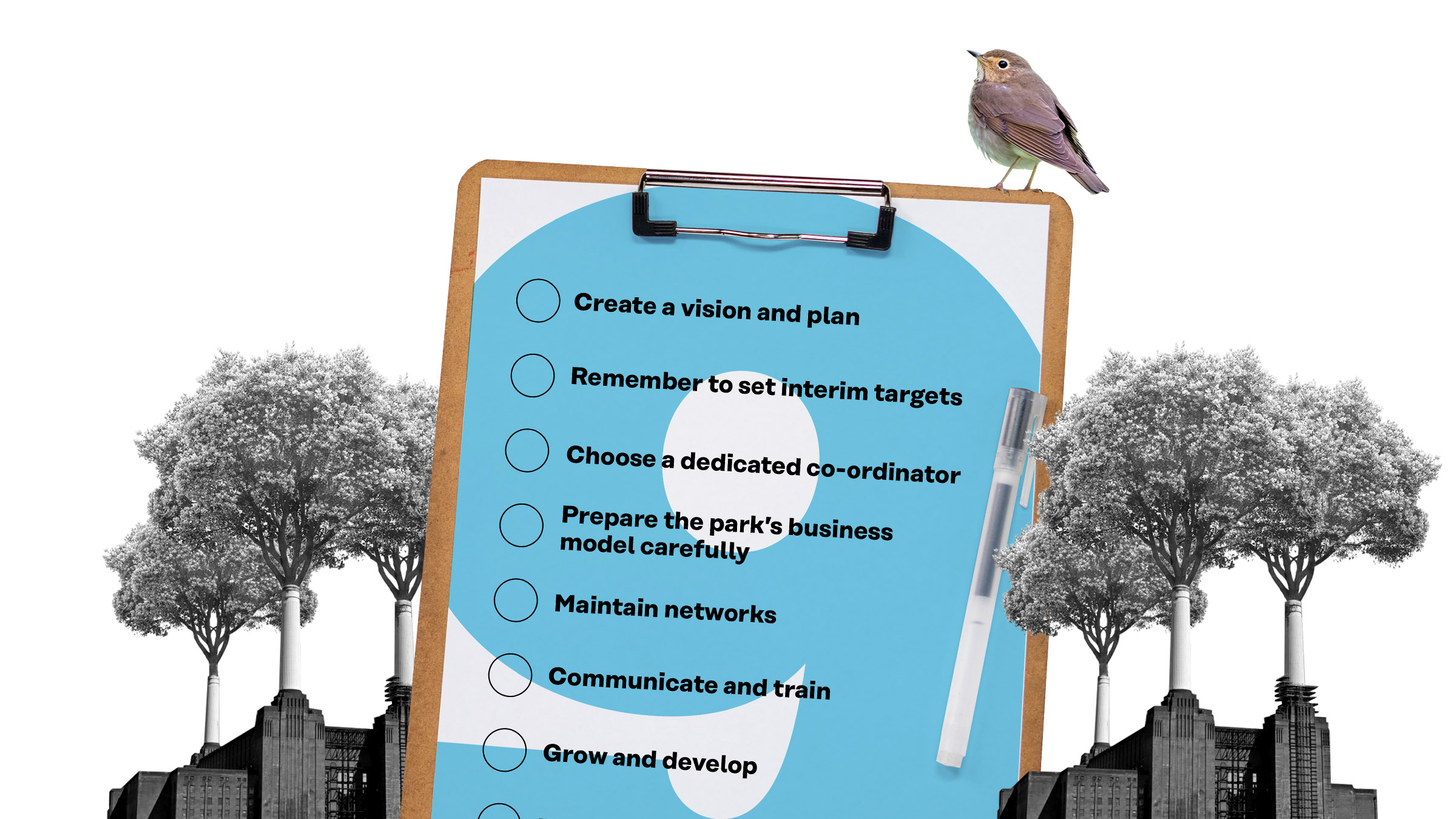What is an eco-industrial park?
An eco-industrial park is a geographically defined area where materials, energy and information circulate between companies. It aims for profitable business while making environmental values a high priority. Eco-industrial parks create added value for the participating companies through co-operation. There are about 20 eco-industrial parks in Finland promoting regional business in line with the principles of sustainable development.
An eco-industrial park can be a cluster of pioneering companies in the field of environmental technology or a source of products and services that respond to the challenges of climate change climate change A broad range of changes happening to our planet due to global warming, which is caused by the increase in the amount of greenhouse gases emitted into the atmosphere as a result of human activity. Open term page climate change . In many cases, the planning of the park’s energy production is also as environmentally sustainable as possible. Energy efficiency and resource efficiency are routine at eco-industrial parks, and the physical proximity between the companies creates important trust capital for them. The networks of companies create substantial cost savings through support services and joint purchasing, for example.
Some eco-industrial parks have emerged organically through co-operation over a long period of time, while others have been built through determined effort.
Land use guides location decisions
Land use planning can be used to create long-term regional competitive advantage. Profiling regions also creates better conditions for marketing and the specialisation of companies. From the perspective of land use, different eco-industrial parks may have different starting positions. The typical starting positions include the following.
- Large geographical areas where companies make use of each other’s side streams despite not being located in the same industrial zone (Kemi-Tornio).
- New bioeconomy The bioeconomy An economy in which renewable natural resources are used to produce food, energy, products and services. Open term page The bioeconomy and circular economy The circular economy An economic model which does not focus on producing more and more goods, but in which consumption is based on using services – sharing, renting and recycling – instead of owning. Materials are not destroyed in the end, but are used to make new products over and over again. Open term page The circular economy parks (Kemijärvi).
- Former landfills and other waste processing areas that are being transformed into recycling/circular economy parks.
- Industrial parks where industrial symbioses based on the bioeconomy and circular economy are built around a significant industrial facility (such as a bioproduct plant) or multiple operators (Äänekoski).
- New eco-industrial park based on a local public-private initiative (Eco3, Nokia).
- Clusters that develop industrial circular economy solutions driven by academic research (Turku Smart Chemistry Park).
What does an eco-industrial park offer for companies?
The infrastructure of an eco-industrial park offers companies significant savings in raw materials, commodity, energy, waste management, production and logistics costs. Cost savings are also achieved through a shared use of premises, maintenance and other services, information and training, as well as purchasing, for example. Synergies between companies also increase material and energy efficiency while reducing negative environmental impacts. Companies in eco-industrial parks also create joint research and development projects and engage in co-operation with universities.
Nine steps to establish an eco-industrial park
1.Create a vision and plan
Think about what kinds of companies the eco-industrial park will serve. Right from the start, take the future growth of the park into consideration when it comes to infrastructure planning and zoning, for example. Consider different financing options early on.
2.Remember to set interim targets
Divide the project into small parts. Milestones support progress. Remember to enjoy the moments of success – even the small victories. Getting started takes time and patience.
3.Choose a dedicated co-ordinator
The park’s operations need to be marketed and co-ordinated. For this, you need a dedicated and reliable co-ordinator for the network. This role is typically assigned to a local or regional development company, one of the park’s companies or an association.
4.Prepare the park’s business model carefully
Make sure that the companies in the eco-industrial park have realistic and financially feasible expectations. New projects may involve new financial risks for companies. On the other hand, new thinking and the clustering of expertise may also present new business opportunities that can be turned into a substantial competitive advantage.
To ensure seamless co-operation between companies, choose an unbiased, public and neutral non-profit co-ordinator. When considering the business model, keep in mind that in the processing and chemical industries, the path from idea to product is long and development efforts require a lot of capital. The industry’s high-growth companies will spark larger corporations’ interest in search of new circular economy and bioeconomy expertise and technologies.
5.Maintain networks
To be highly effective, an eco-industrial park needs companies that are a good match with its profile. It is important that these anchor companies are firmly committed to the park’s operations, as that ensures sufficient financial resources as well as adequate and continuous streams of by-products. The anchor companies also build trust between organisations and maintain the park’s network.
At its best, an eco-industrial park presents a healthy mix of larger and smaller companies operating within the same area. And to keep up with the development, the park should also attract tech start-ups based on academic research.
6.Communicate and train
To prosper, the companies in an eco-industrial park need extensive knowledge and skills related to operating as part of a network. The network co-ordinator can help with the assessment of co-operation opportunities, bringing in financing partners, relaying information and maintaining a dialogue between the companies and the authorities.
7.Grow and develop
When the operations of the eco-industrial park have become well established, think about ways to leverage the companies’ networks to develop collaborative innovation activities as well as shared knowledge and services between the various parties involved in the park. Actively look for new organisations and operating methods for the park.
8.Build and maintain trust
Trust is essential for a successful eco-industrial park. Trust makes it possible to optimise the sharing of know-how and various ideas between the companies. Mutually successful business relationships and social interaction also help maintain an atmosphere of trust.
9.Communicate success
Effective internal communication needs to be supported by success stories. When the companies in the eco-industrial park prosper and grow, the co-ordinator is also partly responsible for spreading the message of their achievements to audiences outside the park. Having shared communication resources in place early on will help increase awareness of the park and its strengths. When this message is spread far and wide, the park will become even more attractive in the eyes of customers and partners. The network also helps determine what are the most appropriate channels and target groups as well as build the right image for the park. There is no need to be overly modest when you describe the park’s success stories.
Eco-industrial parks in Finland
Digipolis, Kemi-Tornio
Kemi-Tornio is a strong and specialised region with a cluster of chemical and mechanical wood processing, paper industry, metal and steel industry, wood construction, metalworking and engineering operations, as well as a significant mining presence. The total amount of industrial side streams suitable for use is approximately 1.7 million tonnes per year. The region produces approximately 8 per cent of the total value of Finland’s exports.
Forestin eco-industrial park, Kemijärvi
Forestin eco-industrial park is located in Kemijärvi in the industrial area of Patokangas, which has a long history of wood processing. The park includes Keitele Group’s sawmill, gluelam and pellet factory, and Finland’s largest raw timber terminal, and it has been earmarked as the site for the planned Boreal Bioref biorefinery. The area has an electrified railway line and plots for industrial use. The park uses the area’s natural material flows and business synergies to produce new bio and circular economy products.
Kokkola Industrial Park, Kokkola
Kokkola Industrial Park (KIP) is the largest inorganic chemical industry ecosystem in northern Europe. There are 17 leading international chemical industry and metal processing industry companies in the park. Most of their products are exported. The park is also home to about 60 service companies that support the core businesses of the industrial companies in the area.
Smart Chemistry Park, Turku
Smart Chemistry Park is an innovation platform and network for start-ups and SMEs delivering new bioeconomy and circular economy solutions. The core business focus of the park’s companies is on refining industrial side streams and biomass to create new products and materials, and there are also consulting companies that complement these activities with their services.
Circular economy village, Riihimäki
The circular economy village in Riihimäki is a co-operation between the City of Riihimäki and Fortum Corporation, concentrating on municipal waste. The industries represented in the village include eco and plastics as well as a biorefinery.
ECO3, Nokia
The ECO3 eco-industrial park is a bio and circular economy pioneer. The park houses a wide variety of activities, including nutrient circulation, a wood-based bio and circular economy, energy and fuel based on a bio and circular economy, and technical circulation.
Kilpilahti industrial area, Porvoo
The Kilpilahti industrial area in Porvoo concentrates on oil products, renewable products and fuels, gas, plastic products and raw materials for plastic products. The park is built around Neste Oyj’s refinery, which produces excess heat.
Metsäjaanu, Salo
Metsäjaanu is an evolving business area for cleantech companies in Salo with excellent transport connections between the cities of Turku, Helsinki and Hanko. The 100-hectare area forms a cluster consisting of 10 companies and almost 100 employees.
Pori-Harjavalta industrial park, Pori and Harjavalta
This group of eco-industrial parks situated in South-West Finland concentrates on the refining of technology metals and the production of technology metal products and chemicals for use in batteries and electric cars needed for the electrification of society. Peittoo Recycling Park in Pori plays an important role in this ecosystem, offering a vast area for the handling, storage and landfill of industrial side streams.
Envi Grow Park, Forssa
The Envi Grow eco-industrial park recycles materials, energy, expertise and information within the waste management, food and construction industries in a closed-loop system that is kind to the environment and good for local business.


















Publication